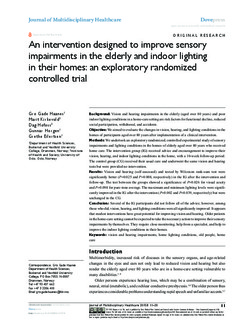| dc.description.abstract | Background: Vision and hearing impairments in the elderly (aged over 80 years) and poor indoor lighting conditions in a home-care setting are risk factors for functional decline, reduced social participation, withdrawal, and accidents.
Objective: We aimed to evaluate the changes in vision, hearing, and lighting conditions in the homes of participants aged over 80 years after implementation of a clinical intervention.
Methods: We undertook an exploratory randomized, controlled experimental study of sensory impairments and lighting conditions in the homes of elderly aged over 80 years who received home care. The intervention group (IG) received advice and encouragement to improve their vision, hearing, and indoor lighting conditions in the home, with a 10-week follow-up period. The control group (CG) received their usual care and underwent the same vision and hearing tests but were provided no intervention.
Results: Vision and hearing (self-assessed) and tested by Wilcoxon rank-sum test were significantly better (P=0.025 and P=0.008, respectively) in the IG after the intervention and follow-up. The test between the groups showed a significance of P=0.026 for visual acuity and P=0.098 for pure-tone average. The maximum and minimum lighting levels were significantly improved in the IG after the intervention (P=0.002 and P=0.039, respectively) but were unchanged in the CG.
Conclusion: Several of the IG participants did not follow all of the advice; however, among those who did, vision, hearing, and lighting conditions were all significantly improved. It appears that modest interventions have great potential for improving vision and hearing. Older patients in the home-care setting cannot be expected to take the necessary action to improve their sensory impairments by themselves. They require close monitoring, help from a specialist, and help to improve the indoor lighting conditions in their homes. | |
